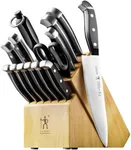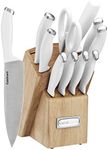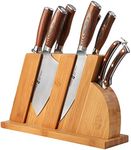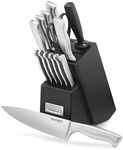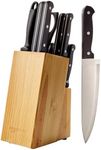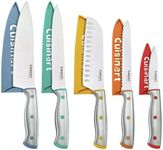Buying Guide for the Best Budget Knife Set
Choosing a knife set can make a big difference in your kitchen experience, whether you're a beginner cook or someone who enjoys preparing meals regularly. The right set will help you cut, slice, and chop more safely and efficiently. When picking a knife set, it's important to look beyond just the number of pieces and focus on the quality and types of knives included, as well as how comfortable and durable they are. Understanding the key features will help you find a set that matches your cooking habits and feels good to use.Blade MaterialBlade material refers to what the knife blades are made from, and it greatly affects sharpness, durability, and ease of maintenance. The most common materials are stainless steel, high-carbon steel, and ceramic. Stainless steel is popular because it resists rust and is easy to care for, but it may need more frequent sharpening. High-carbon steel holds an edge longer but can rust if not dried properly. Ceramic blades are very sharp and lightweight but can chip or break if dropped. If you want something easy to maintain, stainless steel is a safe choice. If you want longer-lasting sharpness and don't mind a bit more care, high-carbon steel is worth considering. Ceramic is best if you want a very light knife and are careful with your tools.
Handle Comfort and MaterialThe handle is what you grip, and its comfort and material can affect how safe and pleasant the knife is to use. Handles are often made from plastic, wood, or composite materials. Plastic handles are lightweight and easy to clean, but can feel slippery when wet. Wood handles look nice and feel warm, but need more care to avoid cracking or absorbing moisture. Composite handles combine the best of both, offering durability and a good grip. If you cook for long periods or have larger hands, look for handles that feel comfortable and secure in your grip. Try to pick a set with handles that feel natural and safe for your hand size and cooking style.
Knife Types IncludedKnife sets can include a variety of knives, such as chef's knives, paring knives, bread knives, and utility knives. The types included determine what tasks you can easily handle. A basic set should have at least a chef's knife (for general chopping), a paring knife (for small tasks), and a bread knife (for slicing bread). Some sets add specialty knives, but more isn't always better if you won't use them. Think about what you cook most often and choose a set that covers those needs without extra pieces you'll never use.
Number of PiecesThe number of pieces in a set can range from just a few to over a dozen, including knives, kitchen shears, and sometimes a sharpening tool or storage block. More pieces can seem appealing, but it's better to have a few high-quality, useful knives than many you rarely use. Consider your cooking habits: if you mostly prepare simple meals, a smaller set will do. If you like to experiment with different recipes, a larger set might be helpful, but make sure each piece serves a purpose.
Ease of MaintenanceEase of maintenance refers to how simple it is to keep your knives clean and sharp. Some knives are dishwasher safe, but hand washing is usually recommended to keep blades sharp and handles in good condition. Some sets come with a sharpening tool, which is useful for keeping your knives in top shape. If you want low-maintenance knives, look for stainless steel blades and handles that can handle regular washing. If you're willing to put in a bit more effort, high-carbon steel or wood handles can offer a better feel and performance.
Storage OptionsKnife sets often come with a storage block, magnetic strip, or protective sheaths. Storage is important for safety and keeping your knives in good condition. A block keeps knives organized and within reach, while a magnetic strip saves counter space. Sheaths are good if you have limited space or want to store knives in a drawer. Think about your kitchen layout and choose a storage option that fits your space and keeps your knives protected.


